I’ve tried Bluetooth kits for hands-free calling in my car. I’ve also tried FM transmitters that plug into my iPod/iPhone to playback music through my car stereo. I’ve never tried any device that could do both until I tried the Bluetooth Internet Radio Car Kit for iPhone from Livio Radio. Plus, you’ll notice the words “internet radio” in the title. Yes, that means that I can stream internet radio from my iPhone to my car stereo. Let’s give it a look.
Click any image for an enlarged view.
In the box
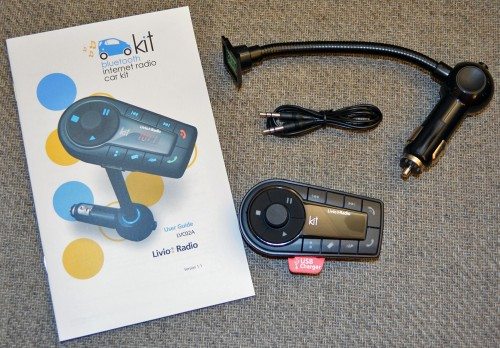 In addition to the Livio receiver, the box contains a 3.5mm-to-3.5mm audio cable, a powered gooseneck stand, and a user’s guide. You’ll notice the gooseneck stand has a connector that plugs into your car’s power outlet. There’s a power button on the other end of that power connector, so you can turn the Livio kit off when you aren’t using it.
In addition to the Livio receiver, the box contains a 3.5mm-to-3.5mm audio cable, a powered gooseneck stand, and a user’s guide. You’ll notice the gooseneck stand has a connector that plugs into your car’s power outlet. There’s a power button on the other end of that power connector, so you can turn the Livio kit off when you aren’t using it.
Tech specifications
- Bluetooth v2.1
- Bluetooth profiles: HSP, HFP, A2DP and AVRCP
- Frequency response: 2.4GHz-2.4835GHz
- FM frequency: 88.1-107.9MHz (US mode) or 87.9-107.9 (EU mode)
- Bluetooth range: 10M
- FM range: 4M
- Input: DC 12V-24V
- USB output: DC 5.0V, 1000mA
- Dimensions: 3.6″ X 1.9″ X 1.1″; 1.6 ounces (main body only)
- 12V adapter with gooseneck: 3 ounces
- Fuse: 2A, 250V
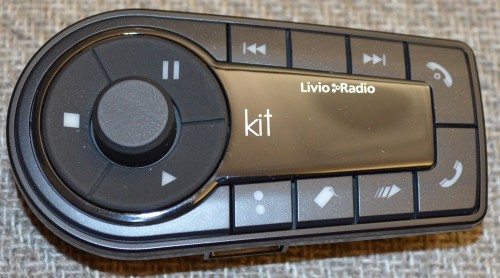 The main section is made of black plastic, and it has a variety of controls, including buttons to launch the internet radio app (bottom left) or to tag a song for later lookup or purchase (the button with the tag icon just to the right of the internet radio app button). There are also buttons to control music playback and to take/make or end calls. The large, circular button at the left is a multi-purpose control for selecting the FM station, changing the volume, or switching between US or European radio standards.
The main section is made of black plastic, and it has a variety of controls, including buttons to launch the internet radio app (bottom left) or to tag a song for later lookup or purchase (the button with the tag icon just to the right of the internet radio app button). There are also buttons to control music playback and to take/make or end calls. The large, circular button at the left is a multi-purpose control for selecting the FM station, changing the volume, or switching between US or European radio standards.
The box is marked to indicate that this device is designed for Apple products, and some of the buttons, such as the launch app and tag song button, may only work with the Apple internet radio app, but the Livio kit should work with other Bluetooth devices for playing music or taking phone calls.
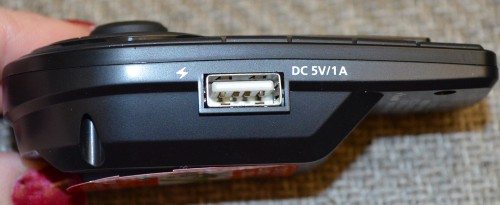 One side of the Livio kit has a USB port that can be used to charge your phone or other USB chargeable devices. You’ll notice the jack provides 5V at 1 amp.
One side of the Livio kit has a USB port that can be used to charge your phone or other USB chargeable devices. You’ll notice the jack provides 5V at 1 amp.
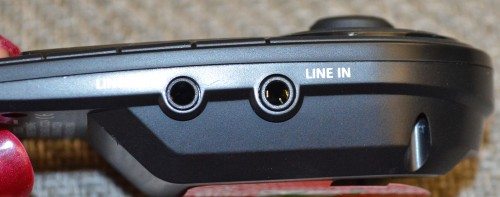 The other side of the kit has a 3.5mm line-in jack that can be used to connect a non-Bluetooth device. The glare prevents you from reading the label for the other 3.5mm jack, but it’s a line-out jack. If your car stereo has a 3.5mm input, you can plug the Livio in so that you don’t use the FM transmitter to get the music to the stereo itself.
The other side of the kit has a 3.5mm line-in jack that can be used to connect a non-Bluetooth device. The glare prevents you from reading the label for the other 3.5mm jack, but it’s a line-out jack. If your car stereo has a 3.5mm input, you can plug the Livio in so that you don’t use the FM transmitter to get the music to the stereo itself.
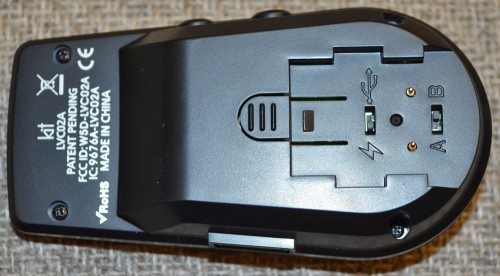 The back of the Livio has the connector for the gooseneck. There are two switches that will be hidden by the gooseneck when it’s connected. The left-most switch controls the operation of the USB port on the side of the Livio. Flip it to the lightning bolt position if you want to be able to charge your device using the USB jack on the side of the Livio. The A/B switch must be set to B to work with an Apple product; A isn’t active at this time.
The back of the Livio has the connector for the gooseneck. There are two switches that will be hidden by the gooseneck when it’s connected. The left-most switch controls the operation of the USB port on the side of the Livio. Flip it to the lightning bolt position if you want to be able to charge your device using the USB jack on the side of the Livio. The A/B switch must be set to B to work with an Apple product; A isn’t active at this time.
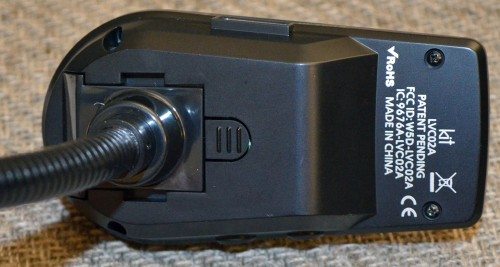 After the gooseneck connector is snapped in place, I was ready to take the Livio out to my car.
After the gooseneck connector is snapped in place, I was ready to take the Livio out to my car.
You can adjust the position of the gooseneck to get the Livio turned so it’s easily seen and used by the driver.
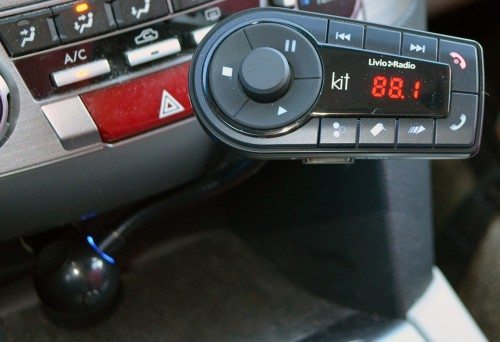 I plugged the power plug into my car’s power outlet and pressed the power button. There’s a blue light on the power plug that lights up to show power is on, and the LED display lights up on the main body of the kit. You’ll need to find a clear FM station that has no static or interference from other stations, then select that station on the Livio. You can also use the Livio to scan for an appropriate station. I always use 88.1, because it’s clear in my area. I followed the instructions for Bluetooth pairing, and my iPhone 5 was connected in no time.
I plugged the power plug into my car’s power outlet and pressed the power button. There’s a blue light on the power plug that lights up to show power is on, and the LED display lights up on the main body of the kit. You’ll need to find a clear FM station that has no static or interference from other stations, then select that station on the Livio. You can also use the Livio to scan for an appropriate station. I always use 88.1, because it’s clear in my area. I followed the instructions for Bluetooth pairing, and my iPhone 5 was connected in no time.
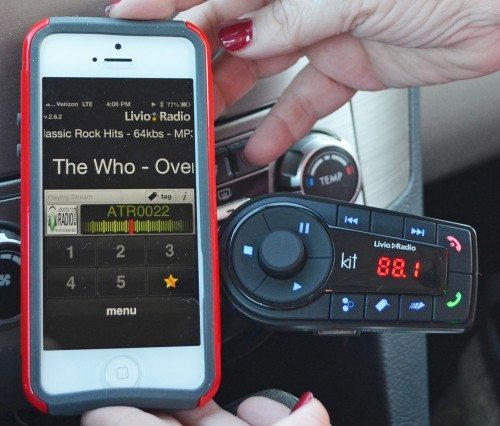 I had already downloaded the free Livio Car Internet Radio app from the iTune’s store, so I started it up, selected a station from the 45,000 or so stations, and had music streaming to my car’s stereo in no time.
I had already downloaded the free Livio Car Internet Radio app from the iTune’s store, so I started it up, selected a station from the 45,000 or so stations, and had music streaming to my car’s stereo in no time.
My car doesn’t have an antenna on the exterior; it has a wire antenna in one of the windows in the cargo area. Livio warned that some cars with this type of antenna may have some issues with the FM transmission, but mine worked fine.
The app has a lot of channels available to you while you are connected to and streaming to the Livio, but they won’t all show up for you if you try to use the app without the Livio – unless you pay for the $4.99 in-app upgrade. The radio has a lot of features, such as allowing you to tag a song you like from the app or by pressing the button on the Livio device so you can look it up or purchase it later. You can tag stations as favorites, and those stations should show up in the free version of the app even when you aren’t connected to the Livio.
Because of the limitations of Bluetooth, I did notice some compression or flattening of the music being sent from the radio app to my car’s stereo. Otherwise, the radio app and Livio transmitter worked great. Of course, it’s internet radio, and that means you’ll be using your data plan to download that music. If you have a truly unlimited data plan (or deep pockets to pay for overages), then you can drive around listening to the internet radio 24/7/365. For those of us with neither unlimited data nor unlimited funds, we’ll need to keep an eye on data usage.
Never fear, though, because I can stream audio from other apps on my iPhone. I was able to easily stream music from my Music app through the Livio to the car stereo. It worked much easier than connecting my iPhone to the stereo through the USB jack built-in to my car. (There’s a manual that has several hundred pages describing how you use that iPod/iPhone connector with my car.) Again, the music was compressed because of the Bluetooth, but it worked fine. I didn’t mind that little bit of compression as a trade-off for not having to memorize that huge manual.
I also have the Bluetooth-enabled 7th-generation of the iPod nano, so I tried it with the Livio. It worked great to stream my music stored on the iPod nano. Of course, it can’t use the Livio internet radio app because it is neither an iOS device nor does it have an internet connection.
I don’t have any non-Apple Bluetooth-enabled devices to try the Livio with, and I didn’t have any non-Bluetooth devices.
And I didn’t forget to try out the hands-free calling features with my phone. I was able to make and receive calls without problems. My caller didn’t sound like he was sitting right beside me; there was a little clipping with the sound of his voice, too. However, he was clear and easy to understand. The Livio has a noise-cancelling microphone, and my caller said I sounded clear and was easy to understand. I did have to talk louder than I normally would because the microphone was closer to the floor of my car than to my mouth.
When I pressed the button to make a call or when my phone rang with an incoming call, the music stopped and stayed off until I ended the call. The music playback resumed immediately when the call ended. In addition to manually starting a call, the Livio will allow me to use the voice-control functions of the phone to make a call.
Livio Radio’s Bluetooth Internet Radio Car Kit for iPhone is a nice addition to a car without a built-in hands-free system for calls or without an interface for plugging your phone directly into the sound system. There is some compression of the music, as I already mentioned, but it’s still very nice to have the option of listening to internet radio or to your iTune’s library instead of just the over-the-air stations. One big caveat is to keep an eye on your data usage, of course. Also, you won’t be able to listen to over-the-air radio at all if you have the Livio turned on simply for hands-free phone calls. Your car’s radio will have to stay turned to the “empty” FM station so that your calls can use the car’s sound system and speakers. You’ll still have options for listening to music that don’t involve data usage, but it won’t be your favorite local radio station.
Apple iPad Air 2 16GB WiFi 2GB iOS 10 9.7in Tablet - Space Gray (Renewed)
$112.99 (as of December 2, 2025 19:29 GMT -05:00 - More infoProduct prices and availability are accurate as of the date/time indicated and are subject to change. Any price and availability information displayed on [relevant Amazon Site(s), as applicable] at the time of purchase will apply to the purchase of this product.)[Apple MFi Certified] Micro SD Card Reader for iPhone iPad,Lightning to Micro SD/TF Card Reader Viewer Adapter Memory Card Reading for iPhone 14/13/12/Pro Max/11/X/XR/8 Support iOS 14 15 16 17 System
$6.98 (as of December 2, 2025 22:15 GMT -05:00 - More infoProduct prices and availability are accurate as of the date/time indicated and are subject to change. Any price and availability information displayed on [relevant Amazon Site(s), as applicable] at the time of purchase will apply to the purchase of this product.)Product Information
| Price: | $45.49 |
| Manufacturer: | Livio Radio |
| Retailer: | Amazon |
| Pros: |
|
| Cons: |
|

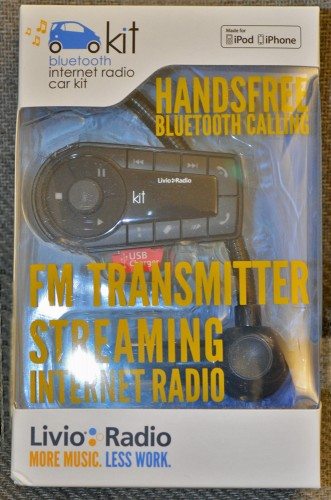


Gadgeteer Comment Policy - Please read before commenting
This is a simpleton question: does the person on the other end’s voice play through the car’s speakers?
Also, when playing music from your iphone/ipod music app, does it play a playlist (and which one?) or does it just play whatever the last setting was (like playing through an album)?
@Jason The music stopped so the call’s sound could come through the speakers.
And it played whatever I selected on my iPhone. It doesn’t control the music on my iPhone/iPod/iPad. It’s a Bluetooth device which simply has a wireless connection that transmits any sounds generated by my mobile device to the Livio and then to the car’s speakers. I have complete control on whatever sounds I choose to have my mobile device play.
Fuse… 250V?? I lost the fuse and need to by a new one, but does not make sense. The 250 V? Could you please verify? Isn’t it 12V?